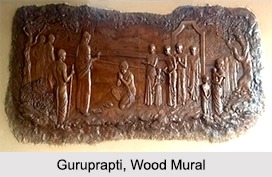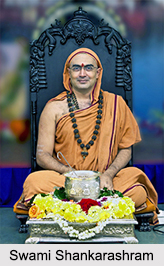 Back to the heavenly days of Hindu rule of Kanara by the chiefs of Nagar in Mysore (1560 - 1768), the History of Shri Chitrapur Math lies beneath. In the services of this kingdom, the Smartha Saraswats were holding high positions on account of their loyalty, integrity and intelligence. With this the other people became jealous. They complained to the king that Saraswat Brahmins did not have a guru and hence no "spiritual existence of their own". So, a decree was issued by the King to them stating that unless the community showed them their guru, they would be heavily penalized. This might included forcing them out from their present administrative posts.
Back to the heavenly days of Hindu rule of Kanara by the chiefs of Nagar in Mysore (1560 - 1768), the History of Shri Chitrapur Math lies beneath. In the services of this kingdom, the Smartha Saraswats were holding high positions on account of their loyalty, integrity and intelligence. With this the other people became jealous. They complained to the king that Saraswat Brahmins did not have a guru and hence no "spiritual existence of their own". So, a decree was issued by the King to them stating that unless the community showed them their guru, they would be heavily penalized. This might included forcing them out from their present administrative posts.
Appearance of Lord Bhavanishankar
The elders of the community, in a state in which all hope is lost, started praying to Lord Mahabaleshwar at Gokarna. The Lord Mahabaleshwar in His mercy appeared to them and ensured them that a Sanyasi would appear at the banks of the Kotiteertha, the temple tank, the following day. He would be their "Guru".
At the given hour on the given day, a Sanyasi appeared at the banks of Kotiteertha. He was a Kashmiri Saraswat Brahmin, who had a dream about coming to the said location by Lord Bhavanishankar himself. He was carrying an idol of Lord Bhavanishankar in his cloth pouch. At the sight of this saint with the idol of their Aradhya-Devata, all the people in the community started rejoicing at Gokarna in 1708. He was formally ordained as Swami Parijnanashram at the "Sri Vishweshwar Vitthal Temple".
Formation of Guru Parampara
The Guru Parampara of the Chitrapur Saraswats was started. Parijnanashram-I Swamiji was the first Guru and Mathadhipati of the Chitrapur Saraswat Brahmins. This Kashmir Saraswat Brahmin was a Sanyasi and was a man of great spiritual grace. The first Matha of the community was established by Him at Gokarna.
 In order to follow the order of the King of Nagar, Swami Parijnanashram went to Sringeri to have consent of His existence from Jagadguru Shankaracharya of Sringeri. But the temple officials of the temple of Goddess Sharadamba were not very much pleased with this decision. So they restricted His entry simply by locking the doors of the temple. Swamiji started praying at the doorsteps.
In order to follow the order of the King of Nagar, Swami Parijnanashram went to Sringeri to have consent of His existence from Jagadguru Shankaracharya of Sringeri. But the temple officials of the temple of Goddess Sharadamba were not very much pleased with this decision. So they restricted His entry simply by locking the doors of the temple. Swamiji started praying at the doorsteps.
The prayer was so intense that Jagadguru Shankaracharya envisioned the callousness of the temple officials that irked Goddess Sharadamba. Shankaracharya called the Swamiji and was very amazed with the in-depth knowledge he owned in the scriptures, his mysticism and his yogic abilities. By offering the "Adda Palaki", "Birdu" and "Bavali", He immediately gave consent to Him. After He offered Swami Parijnanashram his letter of consent, Swamiji has been officially declared as the "Guru" of the Saraswats.
Disciples of Swami Parijnanashram
As the devotees wanted the "Guru Parampara" to continue, they bespoke the ageing Swami Parijnanashram to accept a shishya or disciple who will succeed him as the new "Mathadhipati". By accepting a shishya, the Guruji in a graceful manner palliated their concerns. "Shishya Sweekar" ceremony of His was performed on the Shudha Poornima day in the month of Chaitra in the year 1720 and it was the son of Krishna Kulkarni who became “the chosen oneâ€. Thus, Swami Parijnanashram ordained his new shishya and Swami Shankarashram was ordained as the next "Mathadhipati".
Last Words of Swami Parijnanashram
Swami Parijnanashram"s health was deteriorating with years. Only 14 days after, he attained Maha-samadhi. His last words to Shankarashram were:
“Lead the devotees on the spiritual path and unto the Lord`s grace. Lord Bhavanishankar will always protect you when you face obstaclesâ€.




















